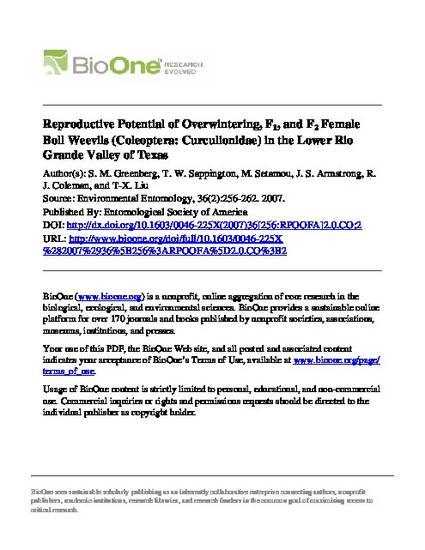
The feeding and oviposition activity of overwintering boll weevils, Anthonomus grandis grandis (Boheman), and seasonal fluctuations in development, survival, and reproduction of progeny of overwintering and first- and second-generation boll weevil females were determined in the laboratory at 27°C, 65% RH, and a photoperiod of 12:12 (L:D) h. During the cotton-free period in the Lower Rio Grande Valley, female boll weevils without access to cotton resorb their unlaid eggs and enter reproductive diapause. However, when they were provided daily with greenhouse-grown cotton squares, commencement of oviposition began after 7, 15, or 20 d, depending on when they were captured. Females captured later in the winter fed longer before laying eggs than those captured in the early fall, suggesting that it may take females longer to terminate diapause the longer they have been dormant. The rate of feeding by females was significantly less during the winter months, and this may have affected the rate of diet-mediated termination of dormancy. Females of the first and second generations after the overwintering generation produced a significantly higher percentage of progeny surviving to adulthood and a higher proportion of these progeny were females. Offspring development time from overwintering female parents was significantly longer than that from first and second generations under the same laboratory conditions. The total number of lifetime eggs produced by females of the second generation during the cotton-growing season were ≈9.9-fold higher than for overwintering females and 1.5-fold higher than for first-generation females. Life table calculations indicated that the population of second-generation boll weevils increased an average of 1.5-fold higher each generation than for females of the first generation and 22.6-fold higher than for overwintering females. Our data showed variation in boll weevil survival, development, and reproductive potential among the overwintering and first- and second-generation females, suggesting inherent seasonal fluctuations in these parameters.
Available at: http://works.bepress.com/thomas_sappington/51/

This article is from Environmental Entomology 36 (2007): 256, doi:10.1603/0046-225X(2007)36[256:RPOOFA]2.0.CO;2